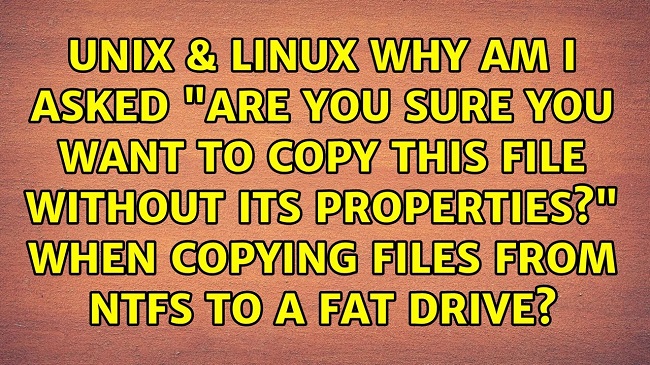It’s possible that Windows will provide you with the following question if you attempt to transfer or move files from an NTFS drive to a drive formatted as FAT (FAT16, FAT32, or any other kind of FAT file system).
Contents
Make The Target Drive an NTFS File System.
You can avoid ever seeing these dialogues by changing the destination drive to NTFS, as they are only generated when files are copied or moved from an NTFS to a FAT drive. But if your drive needs to be a FAT drive in order to be recognised as a storage device by some computers (such radios and some Operating Systems other than Windows), you can’t use this workaround.

But in case that isn’t the case, here’s how to convert a FAT drive to NTFS: Join the FFAT drive to your PC. With the Windows logo key held down and the R button pressed, you may bring up the Run. In the Run box, enter diskmgmt.msc and hit Enter.
Find the FAT drive you want to convert to NTFS in the top pane of the Disk Management software, and then right-click on it. To get the Format… option, right-click anywhere inside the document.
NTFS can be chosen from the drop-down option next to File system. You’re free to give the disc any name you like under the Volume label. Select OK, and then sit tight as the drive is formatted.
After formatting the drive to NTFS, you can safely copy or move any number of files to it without ever again seeing the “Are you sure you want to copy this file without its properties?” prompt.
Find a way to have these dialogues ignored without your intervention using a script.
The most efficient method for avoiding these conversations is to have them automatically replied and removed as soon as they are created. Scripts can be written to automatically dismiss these dialogues by instructing them to copy/move the files in question without the properties that can be copied/moved, which achieves the same result as a human clicking Yes and dismissing the dialogues as soon as they are formed.
To employ this alternative method, you must: Install AutoIT, a free and relatively high-quality script compilation application ZIP file holding the components of the script that will ultimately respond to your pleas for assistance.
Use an unpacking utility like WinRAR to open the downloaded.ZIP file. Find the file entitled stop-copy-dialog.au3 inside the decompressed.ZIP archive, right-click on it, and select Compile script (x86) from the context menu. AutoIT has inserted this choice into your right-click menu.
The stop-copy-dialog.au3 file will now be used to generate an.EXE file by AutoIT. The completed script is an.EXE file; to have your computer run it every time it boots up, you’ll need to create a shortcut to it in the Startup folder. First, you should copy the executable (.EXE) file somewhere secure, then right-click on it and select Create shortcut.
To open the Startup folder, use the Windows logo key + R to bring up the Run dialogue, then type shell:startup and hit Enter. Transfer here the short cut to the AutoIT-generated executable (.EXE) file.
After completing the aforementioned procedures, you may remove AutoIT and discard the downloaded.ZIP file and its unpacked contents. As soon as the script is installed, it will begin executing and responding to these annoying dialogues in near real-time.
To Move or Transfer Files, Try a Third-Party App.
The essential term here is “using Windows’ File Explorer,” as Windows always displays this message every time a file with properties that can only be saved on NTFS storage is moved or copied to a FAT drive.
If you’re a Windows user who is persuaded that this dialogue is annoying and would prefer never to see it again, you can avoid it altogether by switching to a different application for all of your file copying and moving needs.
Even if you try to copy or move a file with properties that can only be saved on NTFS discs to a FAT drive, almost all third-party copying and moving apps will simply ignore such properties and continue with the copy or move nonetheless. TeraCopy is a good example of a third-party file copying and moving tool that may be used to bypass these dialogues.






























